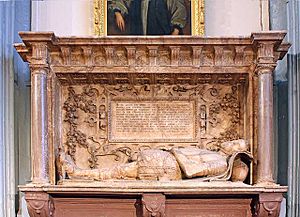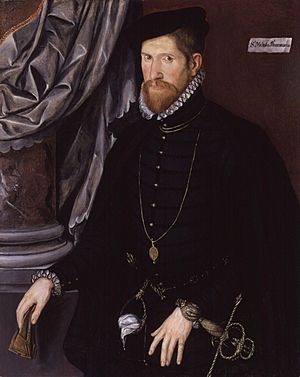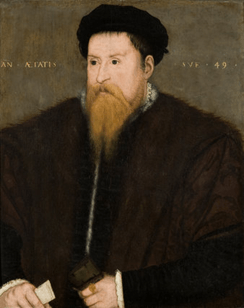Nicholas Throckmorton facts for kids
Sir Nicholas Throckmorton (born around 1515 or 1516, died 12 February 1571) was an important English diplomat and politician. He served as an ambassador to France and later to Scotland. He played a key role in the relationship between Elizabeth I of England and Mary, Queen of Scots.
Contents
Nicholas Throckmorton's Early Life
Nicholas Throckmorton was the fourth of eight sons. His father was Sir George Throckmorton from Coughton Court in Warwickshire. His mother was Katherine, daughter of Nicholas Vaux, 1st Baron Vaux of Harrowden. Nicholas was the uncle of Francis Throckmorton.
He grew up in the homes of the Parr family. This included the household of his cousin, Catherine Parr. Catherine Parr later became the last wife of King Henry VIII of England. Nicholas met young Lady Elizabeth while working for Catherine Parr. Elizabeth was the future Queen. He became a close friend and trusted advisor to her. In his younger years, he also supported the Protestant Reformation.
After some political changes in 1549, Throckmorton became close to John Dudley, 1st Duke of Northumberland. He also became a trusted friend of the young King Edward VI of England.
He served in Parliament from 1545 to 1567. He represented different areas like Maldon and Devizes. During King Edward VI's rule, he was highly favored by the people in charge.
In 1547, he was at the Battle of Pinkie Cleugh during an invasion of Scotland. He was made a knight in 1551. This title brought him land and financial security. He also worked at the Tower mint from 1549 to 1552. He continued to be elected as a Member of Parliament for various places.
Changes in Royal Power
After King Edward VI died in 1553, there was a brief attempt to make Lady Jane Grey queen. Throckmorton tried to stay in touch with both sides. Eventually, he decided to support Queen Mary I.
However, in January 1554, he was suspected of being involved in Wyatt's Rebellion. This was a protest against Queen Mary. He was arrested because of these suspicions. Historians believe he might have been involved. This was possibly due to his Protestant beliefs or his concern about Spanish influence.
Throckmorton was put on trial on 17 April 1554. He managed to convince the jury that he was innocent. The judges, however, were against him. As a result, the court punished the jury and sent Throckmorton to the Tower of London. He was released the next year. He then went to live in France for a while. He was later pardoned in 1557 and worked for Queen Mary.
Serving Queen Elizabeth I
Ambassador to France
When Elizabeth became Queen in November 1558, Throckmorton quickly gained her trust. He had known her personally for a long time. He gave her advice on how to set up her government. From May 1559 to April 1564, he was the ambassador to France. He was also given important lifetime roles in England. He kept sending advice to the Queen, and she often listened to him.
Throckmorton understood that Elizabeth was actively involved in ruling. In August 1560, he wrote to her that peace between England and Scotland depended on her leadership. During his time in France, Throckmorton met Mary, Queen of Scots. He helped arrange her journey back to Scotland from France. Even though he supported the Protestant Reformation, he became a close friend to Mary. He was willing to help her with personal favors.
As an ambassador, Throckmorton encouraged Elizabeth to help the Huguenots. These were French Protestants. He secretly got involved in the French wars of religion. In October 1559, he visited his sick wife in England. Henry Killigrew took his place. When Throckmorton returned to France in 1560, a Catholic leader, Francis, Duke of Guise, had him arrested. Guise believed Throckmorton was involved in a Huguenot plot. Throckmorton later said he feared for his life. However, he was released and kept his job as ambassador.
In 1562, violence increased in France. Throckmorton wanted to support peace efforts. Later that year, he convinced Queen Elizabeth to send military help to the Huguenots. This was called the Newhaven expedition. English troops occupied Le Havre in October 1562. But soon, the Huguenots turned against the English. After an outbreak of illness, the English had to surrender the next year.
The French Queen Mother, Catherine de' Medici, was suspicious of Throckmorton. When Elizabeth sent him to negotiate in 1563, he was placed under house arrest. Elizabeth sent Sir Thomas Smith to help get him released. Throckmorton was eventually released in 1564.
Working with Mary, Queen of Scots
After Throckmorton returned to England, Queen Elizabeth sent him to Scotland in May 1565. His job was to try and stop Mary, Queen of Scots, from marrying Darnley. He went to Stirling Castle but was at first not allowed in. Mary eventually agreed to speak with him. However, the marriage still happened on 16 July.
After Darnley's death, Elizabeth sent Throckmorton to Scotland in June 1567. Scottish lords had rebelled and captured Mary. Elizabeth wanted the lords to put Mary back in charge. Throckmorton himself had advised Elizabeth to support the lords. Mary was held at Lochleven Castle, and Throckmorton was not allowed to see her.
On 25 July 1567, William Maitland of Lethington met with Throckmorton. Throckmorton asked if the plan was to restore Mary to her throne. Elizabeth promised to help find Darnley's killer and protect Mary's son, Prince James. Lethington told Throckmorton that English interference was not welcome. He said it might even put Mary's life in danger.
Elizabeth repeated her instructions to Throckmorton. She told him to argue that the lords had wrongly removed Mary from power. She also worried that the Scottish lords might seek help from France. Throckmorton was told not to attend the coronation of young Prince James. This was to avoid showing approval of the rebellion. Throckmorton sent his assistant instead.
Throckmorton was in a difficult position. He had conflicting orders from Elizabeth and her chief advisor, Sir William Cecil. The Scottish lords knew he was a friend of Mary. They also knew he supported her claim to be Elizabeth's successor. This made him an unwelcome visitor. Some of Elizabeth's messages also upset the lords. Throckmorton was called back to England in August. This happened after he upset Elizabeth by showing his instructions to the Scottish lords.
In 1569, Throckmorton was suspected of being involved in a plan with the Duke of Norfolk. This plan was in favor of Mary, Queen of Scots. He was held for a time at Windsor Castle. He was not put on trial. However, he did not regain the Queen's full trust after this.

Throckmorton died on 12 February 1571. He is buried in St Katharine Cree church in London.
Family and Lasting Impact
Throckmorton married Anne Carew. She was the daughter of Sir Nicholas Carew. They had 10 sons and three daughters. Their daughter Elizabeth later married Sir Walter Raleigh. After Nicholas died, Anne married Adrian Stokes.
Other important people of his time respected Throckmorton. One of them was Sir Francis Walsingham, who had worked with him in France. William Cecil spoke highly of him after his death. This was despite their disagreements.
When he died, Throckmorton held several important positions. These included keeper of Brigstock Park and Justice of the Peace in Northamptonshire. He was also the Chief Butler of England and Wales. A street in London, Throgmorton Street, is named after him.



